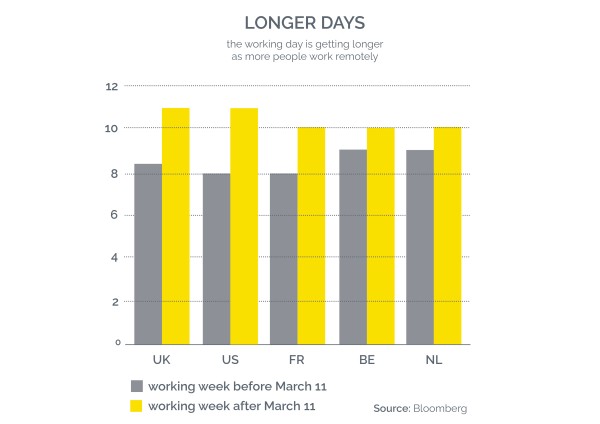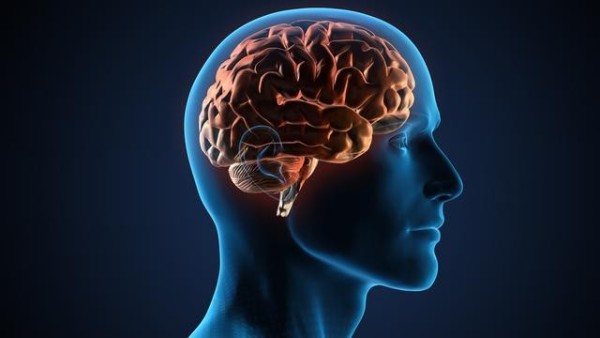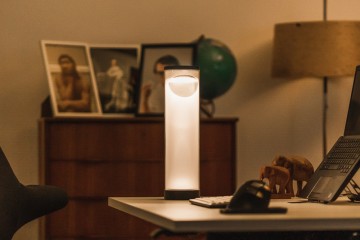Our solutions
Back
What does working from home do to our brain?
A while ago we hosted a webinar with Dr. Erik Matser, clinical Neuropsychologist, about what working from home does to our brain. He took us through the Smile & Sleep conversation, into a 4-hour working day and why exercise is so good for us.
During the COVID-19 epidemic, the vast majority of society had to work from home
Workplaces were urgently created at home, laptops were handed out and a digital meeting environment was created. Some people have an excellent workplace at home, can combine it well with private life and find it no problem to do the social work activities via teams. Other home workers, on the other hand, feel lethargic and tired. They are physically and mentally exhausted. They work longer days, can't just close the work door behind them, and don't close enough from family and work when needed. How come we get overstimulated? What is the role of our brain in this?
Humans are designed to be cognitively active for only 4 hours a day
We have only 4 hours of thinking capacity per day. We are made to combine a thinking process with a motor process. Now, we are overloading our thinking process by working 8 hours a day, and now that we are working at home, maybe even more than 8 hours. We prefer to carry out this thinking process while sitting down, whereas we should be walking, moving and thinking more.
Workplaces were urgently created at home, laptops were handed out and a digital meeting environment was created. Some people have an excellent workplace at home, can combine it well with private life and find it no problem to do the social work activities via teams. Other home workers, on the other hand, feel lethargic and tired. They are physically and mentally exhausted. They work longer days, can't just close the work door behind them, and don't close enough from family and work when needed. How come we get overstimulated? What is the role of our brain in this?
Humans are designed to be cognitively active for only 4 hours a day
We have only 4 hours of thinking capacity per day. We are made to combine a thinking process with a motor process. Now, we are overloading our thinking process by working 8 hours a day, and now that we are working at home, maybe even more than 8 hours. We prefer to carry out this thinking process while sitting down, whereas we should be walking, moving and thinking more.
Our brains are literally exhausted
Is the new normal really so normal? Working from home 4 to 5 days a week, video calling for 3 hours a day, little or no social contact with colleagues and sitting at the kitchen table, the number of screen hours is increasing exponentially.
Various scientific studies1 show that many people are now becoming stressed and tired. Our brain literally becomes exhausted and is no longer as elastic as before. People become more irritable, less able to concentrate and forgetful. All this has a huge impact on our mental and physical condition.
Various scientific studies1 show that many people are now becoming stressed and tired. Our brain literally becomes exhausted and is no longer as elastic as before. People become more irritable, less able to concentrate and forgetful. All this has a huge impact on our mental and physical condition.

We have a unique brain.
The back part of the brain is responsible for the visual process. On the sleep side is the part of the brain that perceives pain, memory and emotions. With the front part of the brain, we make plans and think about the future. From the cradle onwards we are constantly learning new things. We teach our children arithmetic, (foreign) language and geography. We think this is all right. But if you look, we miss a very important thing. People's brains develop up to the age of 21. So what we are doing is giving children knowledge, but we are not paying attention to the literal brain development at all. And that literal brain development has to be stimulated.
From the cradle onwards we are constantly learning new things. We teach our children arithmetic, (foreign) language and geography. We think this is all right. But if you look, we miss a very important thing. People's brains develop up to the age of 21. So what we are doing is giving children knowledge, but we are not paying attention to the literal brain development at all. And that literal brain development has to be stimulated.
Working memory function brain
A working memory function is the basis of intellectual capacity. You get information from the outside in that sticks, and the brain does something with it and gives it back with an edited version and that is how you interact with your working environment. This is how we add quality to our work process. The brain likes to receive information from the outside instead of having to think about it itself. So we need to create a digital world where information is pre-cooked from the outside in and add our own value.
Another thing to avoid is cognitive over-stimulation. We can only think for four hours a day. If you exceed that capacity and the workload becomes too great, a process will start in the brain in which stress hormones are released. If, as an employer, you offer a bearing load of 99% of your limit for overstimulation, then there is nothing wrong with you and you function healthily and mentally fit. If you exceed that load, 101% or 360% doesn't matter much, your brain will give a very specific reaction and stress hormones will be released. A small amount of stress hormone is not bad, but if you are over-stimulated for too long, concentration decreases, muscle pain increases and the energy system runs empty. You have then exceeded your carrying capacity.
From the cradle onwards we are constantly learning new things. We teach our children arithmetic, (foreign) language and geography. We think this is all right. But if you look, we miss a very important thing. People's brains develop up to the age of 21. So what we are doing is giving children knowledge, but we are not paying attention to the literal brain development at all. And that literal brain development has to be stimulated.
Working memory function brain
A working memory function is the basis of intellectual capacity. You get information from the outside in that sticks, and the brain does something with it and gives it back with an edited version and that is how you interact with your working environment. This is how we add quality to our work process. The brain likes to receive information from the outside instead of having to think about it itself. So we need to create a digital world where information is pre-cooked from the outside in and add our own value.
Another thing to avoid is cognitive over-stimulation. We can only think for four hours a day. If you exceed that capacity and the workload becomes too great, a process will start in the brain in which stress hormones are released. If, as an employer, you offer a bearing load of 99% of your limit for overstimulation, then there is nothing wrong with you and you function healthily and mentally fit. If you exceed that load, 101% or 360% doesn't matter much, your brain will give a very specific reaction and stress hormones will be released. A small amount of stress hormone is not bad, but if you are over-stimulated for too long, concentration decreases, muscle pain increases and the energy system runs empty. You have then exceeded your carrying capacity.

Conclusion
Working from home seems easy. But you don't send an employee home with a computer and ask them to sort it out. It doesn't work that way. There has to be a very clear connection with interaction with the digital world. Your thinking must be combined with movement. You have to be able to make small movements at your workstation. And do you have sufficient shielding from stimuli? So that you don't go beyond your emotional capacity, causing you to develop exhaustion.
Working from home is a very complex undertaking. You have to make sure together that the workplace at home is in order. So check the following:
Working from home is a very complex undertaking. You have to make sure together that the workplace at home is in order. So check the following:
- Physical workplace is in order;
- Good digital facilities for communicating (mail, access to the server, remote consultation)
- Is the workplace ergonomically correct for you as a unique person?
- Alternate cognitive skills with movement.
- What is the workload?
Need help? We're here for you
Look at our FAQ or contact us
Many customers preceded you
Read about their experience with BakkerElkhuizen
Select your country and language




